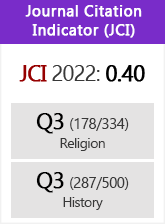¿Tarsis era Tarteso? Lo que los textos bíblicos dicen (y no dicen)
DOI:
https://doi.org/10.3989/hs.2023.19Palabras clave:
Tarsis, Tarteso, Tarso, 1 Reyes, Isaías, Ezequiel, JonásResumen
La ubicación de la Tarsis bíblica en Tarteso goza hoy de bastante aceptación entre arqueólogos e historiadores, aunque hay voces disidentes que la ubican en Tarso de Cilicia o en otras localizaciones. Los estudiosos han esgrimido diferentes pruebas de índole arqueológica, filológica, epigráfica y literaria. En la presente investigación nos fijaremos en la específica prueba bíblica acerca de la identificación entre Tarsis y Tarteso. Estudiaremos los textos bíblicos más relevantes (Génesis 10,4; 1 Reyes 10,22; 22,49; 2 Crónicas 9,21; 20,36; Isaías 23; Ezequiel 26-28, etc.), que han sido empleados frecuentemente como evidencias históricas fehacientes. Se trata, no obstante, de composiciones que fueron escritas bastantes años después de los hechos narrados. Además, es necesario considerar el espesor literario y retórico de unas obras cuyos intereses eran más ideológicos y religiosos que históricos y geográficos. Trataremos así de perfilar qué se puede decir a partir de los textos bíblicos sobre el topónimo Tarsis y qué no se puede (o no se debería) decir.
Descargas
Citas
Albrecht, Felix. 2021. «Die Handelsgüter der Tarsis-Schiffe (1Kön 10,22): Ein Vergleich zwischen Masoretischem Text und Septuaginta». Vetus Testamentum 71: 473-480. https://doi.org/10.1163/15685330-00001151
Albright, William Foxwell. 1961. «The Role of the Canaanites in the History of Civilization». En The Bible in the Ancient Near East: Essays in Honor of William Foxwell Albright, editado por Ernest G. Wright, 328-362. Garden City: Doubleday.
Alonso Schökel, Luis y Cecilia Carniti. 2002. Salmos I. Estella: Verbo Divino.
Baker, David W. 1992a. «Ophir (place)». The Anchor Bible Dictionary. Vol. V: O-Sh, 26-27. New York: Doubleday. https://doi.org/10.5040/9780300261912-0053 PMid:10160864
Baker, David W. 1992b. «Tarshish (place)». The Anchor Bible Dictionary. Vol. VI: Si-Z, 331-333. New York: Doubleday. https://doi.org/10.5040/9780300261929-249
Barré, Michael L. 2004. «Tarshish Has Perished: The Crux of Isaiah 23,10». Biblica 85: 115-119.
Beitzel, Barry J. 2010. «Was There a Joint Nautical Venture on the Mediterranean Sea by Tyrian Phoenicians and Early Israelites?». Bulletin of the American Schools of Oriental Research 360: 37-66. https://doi.org/10.1086/BASOR41104418
Benedicto XVI - Joseph Ratzinger. 2012. La infancia de Jesús. Barcelona: Planeta.
Beuken, Willem A. M. 2007. Jesaja 13-27. Herders theologischer Kommentar zum Alten Testament. Freiburg im Breisgau: Herder.
Blázquez Martínez, José María. 1969. «Fuentes griegas y romanas referentes a Tartessos». En Tartessos y sus problemas. V Symposium internacional de Prehistoria Peninsular, 91-110. Barcelona: Universidad de Barcelona.
Block, Daniel I. 1998. The Book of Ezekiel. Chapter 25-48. The New International Commentary on the Old Testament. Grand Rapids: Eerdmans.
Boer, Roland. 2014. «Fleets of Tarshish: Trading Ventures and Other Tall Tales of the Bible». Scandinavian Journal of the Old Testament 28: 58-80. https://doi.org/10.1080/09018328.2014.926694
Bordreuil, Pierre, Felice Israel y Dennis Pardee. 1996. «Deux ostraca paléo-hébreux de la collection Sh. Moussaïeff». Semitica 46: 49-76.
Borger, Rykle von. 1956. Die Inschriften Asarhaddons, Königs von Assyrien. Archiv für Orientforschung Beih. 9. Im Selbstverlage des Herausgebers: Graz.
Brochart, Samuel. 1646. Geographia Sacra, sur les premiers âges du monde. Caen: Pierre Cardonelle.
Campos, Juan Manuel y Jaime Alvar. 2013. Tarteso. El emporio del metal. Córdoba: Almuzara.
Castillo, Arcadio del 2003. «Tarsis en la estala de Nora: ¿un topónimo de Occidente?». Sefarad 63: 3-32. https://doi.org/10.3989/sefarad.2003.v63.i1.526
Celestino, Sebastián y Carolina López-Ruiz. 2016. Tartessos and the Phoenicians in Iberia. Oxford: Oxford University Press.
Celestino, Sebastián y Carolina López-Ruiz. 2020. Tarteso y los fenicios de occidente. Córdoba: Almuzara.
Das, Andrew. 2008. «Paul of Tarsus: Isaiah 66.19 and the Spanish Mission of Romans 15.24, 28». New Testament Studies 54: 60-73. https://doi.org/10.1017/S0028688508000040
Day, John. 2012. «Where Was Tarshish?». In Let Us Go Up to Zion: Essays in Honour of H. G. M. Williamson on the Occasion of his Sixty-Fifth Birthday, edited by Ian Provan & Mark Boda. Vetus Testamentum Supplements 153, 359-369. Leiden: Brill. https://doi.org/10.1163/9789004226586_029 PMid:23116974
Ephal, Israel y Joseph Naveh. 1998. «Remarks on the Recently Published Moussaieff Ostraca». Israel Exploration Journal 48: 269-273.
Eshel, Tzilla, Yigal Erel, Naama Yahalom-Mack y Ayelet Gilboa. 2019. «Lead Isotopes in Silver Reveal Earliest Phoenician Quest for Metals in the West Mediterranean». Proceedings of the National Academy of Sciences 116/13: 6007-6012. https://doi.org/10.1073/pnas.1817951116 PMid:30804182 PMCid:PMC6442568
Fernández Marcos, Natalio y José Ramón Busto Saiz. 1992. El texto antioqueno de la Biblia griega. II: 1-2 Reyes. Madrid: Instituto de Filología del CSIC.
Fernández Marcos, Natalio y María Victoria Spottorno Díaz-Caro (coord.). 2011. La Biblia Griega Septuaginta. II: Libros históricos. Biblioteca Estudios Bíblicos 126. Salamanca: Sígueme.
Ferrer Albelda, Eduardo, María Cruz Marín Ceballos y Álvaro Pereira Delgado (eds). 2012. La religión del mar. Dioses y ritos de navegación en el Mediterráneo Antiguo. Spal Monografías 16. Sevilla: Editorial de la Universidad de Sevilla.
Finkelstein, Israel y Neil Asher Silberman. 2007. David y Salomón. En busca de los reyes sagrados de la Biblia y de las raíces de la tradición occidental. Madrid: Siglo XXI.
Flint, Peter W. (1988). «The Septuagint Version of Isaiah 23:1-14 and the Masoretic Text». Bulletin of the International Organization for LXX and Cognate Studies 21: 35-57.
Goldingay, John. 2020. Genesis. Baker Commentary on the Old Testament. Grand Rapids: Baker.
Goldwasser, Orly. 2006. «Canaanities Reading Hieroglyphs. Horus is Hathor? The invention of Alphabet in Sinai». Ägypten und Levante 16: 121-160. https://doi.org/10.1553/AEundL16s121
González de Canales, Fernando, Leonardo Serrano, y Jorge Llompart. 2010. «Tarshish and the United Monarchy of Israel». Ancient Near Eastern Studies 47: 137-164.
Goren, Yuvan, Shlomo Bunimovitz, Israel Finkelstein y Nadav Na'Aman. 2003. «The Location of Alashiya: New Evidence from Petrographic Investigation of Alashiyan Tablets from El-Amarna and Ugarit». American Journal of Archaeology 107: 233-255. https://doi.org/10.3764/aja.107.2.233
Görg, Manfred. 1981. «Ophir, Tarschisch und Atlantis: Einige Gedanken zur symbolischen Topographie». Biblische Notizen 15: 76-86.
Hagedorn, Anselm C. 2012. «Tyre and the Mediterranean in the Book of Isaiah». In Let Us Go Up to Zion: Essays in Honour of H. G. M. Williamson on the Occasion of his Sixty-Fifth Birthday, editado por Ian Provan y Mark Boda. Vetus Testamentum Supplements 153: 127- 142. Leiden: Brill. https://doi.org/10.1163/9789004226586_011
Hamilton, Victor P. 1990. The Book of Genesis. Chapters 1-17. The New International Commentary on the Old Testament. Grand Rapids: Eerdmans.
Hernández, Carlos Martín. 2018. «Trans-Mediterranean Silvertrade from the Perspective of Iberian Ores and Hacksilber in the Cisjordan Corpus». Folia Phoenicia 2: 87-91.
Hossfeld, Frank Lothar y Erich Zenger. 2005. Psalms 2: A Commentary on Psalms 51-100. Hermeneia. Minneapolis: Ausgburg Fortress.
Hyppolytus of Rome. 2017. Commentary on Daniel and «Chronicon». Ed. T. C. Schmidt. Gorgias Studies in Early Christianity and Patristics 67. Piscataway: Gorgias Press.
Japhet, Sara. 2003. 2 Chronik. Herders theologischer Kommentar zum Alten Testament. Freiburg in Breisgau: Herder.
Kalimi, Isaac. 2005. The Reshaping of Ancient Israelite History in Chronicles. Winona Lake: Eisenbrauns. https://doi.org/10.1515/9781575065304 PMid:15725946
Klein, Ralph W. 2006. 1 Chronicles: A Commentary. Hermeneia. Minneapolis: Fortress.
Klein, Ralph W. 2012. 2 Chronicles: A Commentary. Hermeneia. Minneapolis: Fortress.
Knauf, Ernst Axel. 2016. 1 Könige 1-14. Herders theologischer Kommentar zum Alten Testament. Freiburg im Breisgau: Herder.
Koch, Michael. 1984. Tarschisch und Hispanien. Madrider Forschungen 14. Berlin: W. de Gruyter. Traducción española: 2003. Tarsis e Hispania: estudios histórico-geográficos y etimológicos sobre la colonización fenicia de la Península Ibérica. Trad. Manuel Pietro Vilas. Madrid: Centro de Estudios Fenicios y Púnicos.
Koehler, Ludwig y Walter Baumgartner. 1999. The Hebrew and Aramaic Lexicon of the Old Testament. 4: ת - שׁ . Leiden: Brill.
Kooij, Arie van der. 1998. The Oracle of Tyre: The Septuagint of Isaiah XXIII as Version and Vision. Vetus Testamentum Supplements 71. Leiden: Brill.
Leichty, Erle. 2011. The Royal Inscriptions of Esarhaddon, King of Assyria (680-669 BC). The Royal Inscriptions of the Neo- Assyrian Period 4. Winona Lake: Eisenbrauns. https://doi.org/10.1515/9781575066462
Lemaire, André. 2000. «Tarshish-Tarsisi: problème de topographie historique biblique et assyrienne». En Studies in Historical Geography and Biblical Historiography Presented to Zecharia Kallai, editado por G. Galil y M. Weinfeld. Vetus Testamentum Supplements 81, 44-62. Leiden: Brill. https://doi.org/10.1163/9789047400349_007
Lipiński, Edward. 2004. Itineraria Phoenicia. Orientalia Lovaniensia Analecta 127; Studia Phoenicia 18. Leuven: Peeters.
López-Ruiz, Carolina. 2009. «Tarshish and Tartessos Revisited: Textual Problems and Historical Implications». En Colonial Encounters in Ancient Iberia: Phoenician, Greek, and Indigenous Relations, editado por M. Dietler y C. López-Ruiz, 244-280. Chicago: The University of Chicago Press. https://doi.org/10.7208/chicago/9780226148489.003.0010
Montenegro, Julia y Arcadio del Castillo. 2016. «The Location of Tarshish: Critical Consideration», Revue Biblique 123: 239-268.
Mulder, Martin J. 1998. 1 Kings. Vol. 1: 1 Kings 1-11. Historical Commentary on the Old Testament. Leuven: Peeters.
Myro, María del Mar. 1993. «Los enigmas de Tarteso: apéndices documentales». En Los enigmas de Tarteso, editado por Jaime Alvar y José María Blázquez, 201-246. Madrid: Cátedra.
Na'aman, Nadav. 2019. «Hiram of Tyre in the Book of Kings and in the Tyrian Records». Journal of Near Eastern Studies 78: 75-85. https://doi.org/10.1086/701707
Newman, B. M. 1982. «Some Hints on Solving Textual Problems». The Bible Tanslator 33: 430-435. https://doi.org/10.1177/026009438203300407
Padilla Monge, Aurelio. 2015. «Un tema recurrente: Tarshish y la Península Ibérica». Aula Orientalis 33(2): 287-308.
Pellicer, José. 1772. Población y lengua primitiva de España. Valencia: Benito Macé.
Pineda, Juan de. 1609. Ad suos in Salomonen comentarios Salomon praevius, id est, de rebus Salomonis regis libri octo. Lyon: Horace Gardon.
Puech, Émile 2020. «La stele et le fragment pheniciens de Nora en Sardaigne et Tarsis». En Un viaje entre el Oriente y el Occidente del Mediterráneo. IX Congreso Internacional de Estudios Fenicios y Púnicos, coordinado por Sebastián Celestino Pérez y Esther Rodríguez, tomo 1: 317-325. Mytra 5. Mérida: Instituto de Arqueología de Mérida.
Ravasi, Gianfranco. 1986. Il libro dei Salmi. Volume II (51-100). Bologna: EDB.
Roberts, J. J. M. 2015. First Isaiah: A Commentary. Hermeneia. Minneapolis: Ausburg Fortress.
Schulten, A. (1922). Tartessos: Ein Beitrag zur ältesten Geschichte des Westens. Hamburg: L. Friederichsen.
Scolnic, Benjamin y Thomas Davis. 2015. «How Kittim became "Rome": Dan 11,30 and the Importance of Cyprus in the Sixth Syrian War». Zeitschrift für die alttestamentliche Wissenschaft 127: 304-319. https://doi.org/10.1515/zaw-2015-0018
Ska, Jean-Louis. 2015. «La Tabla de las Naciones». En El Pentateuco un filón inagotable, 114-118. Verbo Divino: Estella.
Wenham, Gordon J. 1987. Genesis 1-15. Word Biblical Commentary 1. Dallas: Word.
Wutz, Franz. 1914-1915. Onomastica Sacra. Untersuchungen zum Liber Interpretationis nominum hebraicorum des Hl. Hieronymus 1-2. Texte und Untersuchungen zur Geschichte der altchristlichen Literatur 41. Leipzig: Hinrichs.
Descargas
Publicado
Cómo citar
Número
Sección
Licencia
Derechos de autor 2024 Consejo Superior de Investigaciones Científicas (CSIC)

Esta obra está bajo una licencia internacional Creative Commons Atribución 4.0.
© CSIC. Los originales publicados en las ediciones impresa y electrónica de esta Revista son propiedad del Consejo Superior de Investigaciones Científicas, siendo necesario citar la procedencia en cualquier reproducción parcial o total.Salvo indicación contraria, todos los contenidos de la edición electrónica se distribuyen bajo una licencia de uso y distribución “Creative Commons Reconocimiento 4.0 Internacional ” (CC BY 4.0). Puede consultar desde aquí la versión informativa y el texto legal de la licencia. Esta circunstancia ha de hacerse constar expresamente de esta forma cuando sea necesario.
No se autoriza el depósito en repositorios, páginas web personales o similares de cualquier otra versión distinta a la publicada por el editor.














